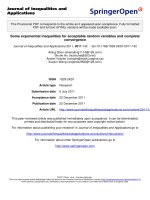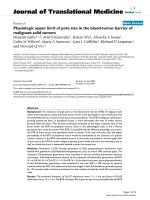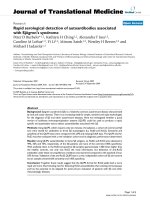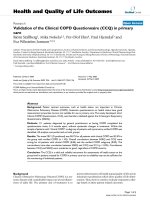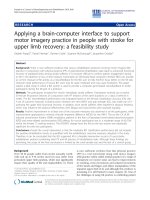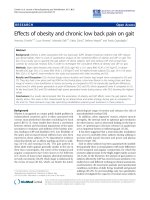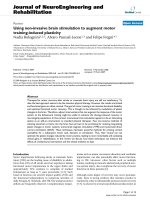báo cáo hóa học:" Spontaneous upper limb monoplegia secondary to probable cerebral amyloid angiopathy" docx
Bạn đang xem bản rút gọn của tài liệu. Xem và tải ngay bản đầy đủ của tài liệu tại đây (1.46 MB, 15 trang )
This Provisional PDF corresponds to the article as it appeared upon acceptance. Fully formatted
PDF and full text (HTML) versions will be made available soon.
Spontaneous upper limb monoplegia secondary to probable cerebral amyloid
angiopathy
International Journal of Emergency Medicine 2012, 5:1 doi:10.1186/1865-1380-5-1
Ahmed-Ramadan Sadek ()
Nandita K Parmar ()
Norah-Hager Sadek ()
Sanjana Jaiganesh ()
Samer Elkhodair ()
Thiagarajan Jaiganesh ()
ISSN 1865-1380
Article type Case report
Submission date 16 June 2011
Acceptance date 3 January 2012
Publication date 3 January 2012
Article URL />This peer-reviewed article was published immediately upon acceptance. It can be downloaded,
printed and distributed freely for any purposes (see copyright notice below).
Articles in International Journal of Emergency Medicine are listed in PubMed and archived at
PubMed Central.
For information about publishing your research in International Journal of Emergency Medicine go to
/>For information about other SpringerOpen publications go to
International Journal of
Emergency Medicine
© 2012 Sadek et al. ; licensee Springer.
This is an open access article distributed under the terms of the Creative Commons Attribution License ( />which permits unrestricted use, distribution, and reproduction in any medium, provided the original work is properly cited.
1
Spontaneous upper limb monoplegia secondary to
probable cerebral amyloid angiopathy
Ahmed-Ramadan Sadek
*1,2,3
, Nandita K. Parmar
3
, Norah-Hager
Sadek
3
, Sanjana Jaiganesh
4
, Samer Elkhodair
3
, Thiagarajan
Jaiganesh
3
1
Wessex Neurological Centre, Southampton University
Hospitals NHS Trust, Tremona Road, Southampton SO16 6YD,
UK.
2
Division of Clinical Neurosciences, School of Medicine,
University of Southampton, Tremona Road, Southampton
SO16 6YD, UK.
3
Emergency Medicine Department, St. Georges Hospital,
Blackshaw Road, Tooting, London, SW17 0QT, UK.
4
James Allen School, Dulwich, London, UK.
*Corresponding author:
Email addresses:
2
AS:
NKP:
NS:
SJ:
SE:
TJ:
Abstract
Cerebral amyloid angiopathy is a clinicopathological
disorder characterised by vascular amyloid deposition
initially in leptomeningeal and neocortical vessels, and later
affecting cortical and subcortical regions. The presence of
amyloid within the walls of these vessels leads to a
propensity for primary intracerebral haemorrhage. We
report the unusual case of a 77-year-old female who
presented to our emergency department with sudden onset
isolated hypoaesthesia and right upper limb monoplegia. A
CT scan demonstrated a peripheral acute haematoma
involving the left perirolandic cortices. Subsequent magnetic
resonance imaging demonstrated previous superficial
haemorrhagic events. One week following discharge the
patient re-attended with multiple short-lived episodes of
aphasia and jerking of the right upper limb. Further imaging
3
demonstrated oedematous changes around the previous
haemorrhagic insult. Cerebral amyloid angiopathy is an
overlooked cause of intracerebral haemorrhage; the isolated
nature of the neurological deficit in this case illustrates the
many guises in which it can present.
4
Introduction
Cerebral amyloid angiopathy is an important yet often
unrecognised cause of primary intracerebral haemorrhage
(PICH). Typically amyloid β-protein (Aβ) is deposited within
the walls of cortical arteries, veins, capillaries and
leptomeningeal vessels [1]. Deposition of Aβ within these
structures can lead to infarction and haemorrhage [2, 3]. In
the absence of definitive histological examination the
condition cannot be diagnosed, and cases are termed
“probable” or “possible” on the basis of imaging studies.
Often the diagnosis is overlooked as a causative agent of
PICH despite evidence that suggests up to 40% of elderly
brains contain cerebrovascular amyloid [4]. Indeed post-
mortem evidence suggests that up to 10% of all PICHs are
attributable to cerebral amyloid angiopathy (CAA) [4].
Herein we described, to our knowledge, the unique case of a
patient who presented with isolated right upper limb
weakness secondary to probable cerebral amyloid
angiopathy.
Case report
A 77-year-old female presented to our emergency department
with a history of sudden right upper limb weakness and altered
5
sensation. The patient was previously fit and well with an
unremarkable medical history. On examination, she was
apyrexial, normotensive and normoglycaemic with a Glasgow
Coma Scale of 15/15. Neurological examination revealed right
upper limb hypotonia and power of 0/5 in all hand and wrist
muscle groups, 2 over 5 power in biceps and triceps, and 3/5
power in the shoulder girdle. Hypoaesthesia was noted
throughout the right upper limb. The remainder of the
neurological examination did not reveal any other deficits.
Baseline blood investigations were normal. An urgent CT brain
was performed and demonstrated a peripheral acute haematoma
involving the left perirolandic cortices with extension over the
left lateral cerebral convexity (Figure 1a,b). Blood was also
noted tracking within the left central sulcus on a background of
modest cerebral small vessel disease and generalised cerebral
volume loss. Brain MRI with diffusion, and T2 gradient echo
demonstrated a haematoma located peripherally within the left
parietal lobe with surrounding oedema (Figure 1c) and mild
compression of the precentral gyrus in the absence of midline
shift. Additionally a mature region of haemorrhage was noted on
the right precentral sulcus with an area of superficial cortical
scarring and haemosiderin deposition over the surface of the
right cerebral hemisphere. Mild ischaemic change was noted
throughout the cerebral white matter in the absence of infarcts
within the basal ganglia, brainstem or cerebellum. Cerebral
6
venography was not performed, but inspection of the sinuses
was not suggestive of a recent thrombosis. Collectively the
imaging studies were indicative of an acute parenchymal event
with evidence of previous superficial bleeds. Following little
improvement in right arm function, after neuro-rehabilitation,
the patient was discharged to her usual residence. One week
following discharge the patient re-attended our department with
multiple 5-min episodes of loss of speech and jerking movement
of the right arm. Subsequent CT brain scan and MRI did not
demonstrate either repeat haemorrhagic or new ischaemic
events. The focal motor seizures were attributed to oedematous
changes surrounding the previous haemorrhagic event (Figure
1d). The patient was started on anti-epileptic medication with no
further seizure activity prior to discharge.
Discussion
Cerebral vascular abnormalities secondary to Aβ deposition
were first described over 70 years ago [5]. Cerebral amyloid
angiopathy is not an uncommon pathological finding,
especially in the aged brain and in those with Alzheimer’s
dementia [4]. The diagnosis of PICH secondary to CAA is
often overlooked, as it is dependent on histological
examination of cerebral tissue. In the absence of definitive
histopathological examination the diagnosis of PICH
7
secondary to CAA is made on the basis of radiological
findings and is termed “probable” or “possible”. Probable
cases of CAA on radiological examination have evidence of
multiple lobar haemorrhagic events, whilst possible
diagnoses only possess evidence of a single event (see
Figure 2) [6]. The condition is rarely observed in those
under 55 years of age [7], and up to 36% of those aged
between 60-97 years of age possess varying degrees of CAA
on post-mortem examination [8].
Despite the persistent decline in haemorrhagic stroke
mortality in those under 74 years of age [9], it is increasingly
apparent that those greater than 75 years of age may have
an increasing incidence of PICH, which may be attributable
to CAA [10]. With improved management of hypertension,
the percentage of PICH attributable to CAA is likely to
become more evident. Indeed one study has demonstrated
that up to 74% of lobar PICHs are secondary to CAA [6].
The clinical manifestations of CAA are variable; however
PICH is the most common presentation. There are no
pathognomonic clinical features, with many patients being
completely asymptomatic. Headaches, altered conscious
level, neurological deficits, seizures and cognitive
8
impairment on a background of dementia are recognised
symptoms. Spontaneous haemorrhagic events secondary to
CAA can also be asymptomatic and are referred to as
“microbleeds” [11]. Due to the predilection of Aβ deposition
in superficial cortical and leptomeningeal vessels
haemorrhagic events tend to be lobar in location [12]; this is
in contrast to hypertensive PICHs, which tend not to be. The
size of the haematoma is typically related to the extent of the
neurological deficit. Previous reports describe patients who
present with unilateral hemiparesis or hemiplegia with
preceding headache and altered conscious level [13]. Our
case was unusual in that the patient only had monoplegia in
her right upper limb, with no preceding symptoms.
Radiological investigation demonstrated both new and old
cerebrovascular events, consistent with a “probable”
diagnosis on the basis of the Boston CAA criteria [12] (see
Figure 2).
The management of patients with PICH secondary to
probable CAA is no different from PICH as a result of any
other aetiology. It has been previously thought that Aβ
within the media and adventitia of cortical and
leptomeningeal blood vessels may interrupt
vasoconstriction during haemostasis following an ICH,
9
making neurosurgical intervention unsafe [14]. A large case
series has, more recently, demonstrated that neurosurgical
intervention can be safely considered in patients <75 years
without parietal and intraventricular haematoma [15]. No
strict guidelines exist addressing secondary prevention of
PICH due to CAA; however it would seem prudent to manage
high blood pressure and advise a reduction in alcohol
consumption [7]. There are presently several ongoing drug
development studies addressing strategies targeting the
production and clearance of Aβ [16]; however none of these
agents have yet been approved for use in CAA. Ultimately,
clinicians need to be aware that CAA is an important cause of
PICH and need to consider it in the elderly patient who has
no other clear aetiological cause for their cerebral
haemorrhage.
Abbreviations
CAA, cerebral angiopathy; CT, computerised tomography;
ICH, intracerebral haemorrhage; MRI, magnetic resonance
imaging.
Consent
Written informed consent was obtained from the patient for
publication of this case report and any accompanying
10
images. A copy of the written consent is available for review
by the Editor-in-Chief of this journal.
Competing interests
The author(s) declare that they have no competing interests.
Authors’ contributions
ARS wrote the first draft of the paper and coordinated the
review of all the drafts. NKP reviewed and commented on all
the drafts of the paper. NHS reviewed and commented on all
the drafts of the paper. SJ searched and extracted relevant
literature for the article. SE reviewed and commented on all
the drafts of the paper. TJ reviewed and commented on all
the drafts of the paper. All authors reviewed and commented
on all radiographic images.
Funding and sponsorship
None
Acknowledgements
ARS is in receipt of the Jason Brice Fellowship in
neurosurgical research and the Walport Academic Clinical
Fellowship in Neurosurgery.
References
11
1. Grinberg LT, Thal DR. Vascular pathology in the aged
human brain. Acta Neuropathol. 2010 Mar;119(3):277-90.
2. McCarron MO NJ, Stewart J, Ironside JW, Mann DM.
Parenchymal brain haemorrhage. In: H K, editor.
Cerebrovascular diseases. Basel: Neuropath Press; 2005. p.
294-300.
3. Petito C. The neuropathology of focal brain ischaemia.
In: H K, editor. Cerebrovascular diseases. Basel: Neuropath
Press; 2005. p. 215-21.
4. Jellinger KA. Alzheimer disease and cerebrovascular
pathology: an update. J Neural Transm. 2002 May;109(5-
6):813-36.
5. Scholz W. Studien zur Pathologie der Hirngefasse II. Die
drusige Entartung der Hirnarterien und -capillaren. Z
Gesamte Neurol Psychiatr. 1938;162:694-715.
6. Knudsen KA, Rosand J, Karluk D, Greenberg SM. Clinical
diagnosis of cerebral amyloid angiopathy: validation of the
Boston criteria. Neurology. 2001 Feb 27;56(4):537-9.
7. Thanvi B, Robinson T. Sporadic cerebral amyloid
angiopathy an important cause of cerebral haemorrhage in
older people. Age Ageing. 2006 Nov;35(6):565-71.
8. Gilbert JJ, Vinters HV. Cerebral amyloid angiopathy:
incidence and complications in the aging brain. I. Cerebral
hemorrhage. Stroke. 1983 Nov-Dec;14(6):915-23.
9. Lawlor DA, Smith GD, Leon DA, Sterne JA, Ebrahim S.
Secular trends in mortality by stroke subtype in the 20th
century: a retrospective analysis. Lancet. 2002 Dec
7;360(9348):1818-23.
10. Lovelock CE, Molyneux AJ, Rothwell PM. Change in
incidence and aetiology of intracerebral haemorrhage in
Oxfordshire, UK, between 1981 and 2006: a population-
based study. Lancet Neurol. 2007 Jun;6(6):487-93.
11. Greenberg SM, Vernooij MW, Cordonnier C,
Viswanathan A, Al-Shahi Salman R, Warach S, et al. Cerebral
microbleeds: a guide to detection and interpretation. Lancet
Neurol. 2009 Feb;8(2):165-74.
12
12. Biffi A, Greenberg SM. Cerebral amyloid angiopathy: a
systematic review. J Clin Neurol. 2011 Mar;7(1):1-9.
13. Panicker JN, Nagaraja D, Chickabasaviah YT. Cerebral
amyloid angiopathy: A clinicopathological study of three
cases. Ann Indian Acad Neurol. 2010 Jul;13(3):216-20.
14. Ishii N, Nishihara Y, Horie A. Amyloid angiopathy and
lobar cerebral haemorrhage. J Neurol Neurosurg Psychiatry.
1984 Nov;47(11):1203-10.
15. Izumihara A, Ishihara T, Iwamoto N, Yamashita K, Ito H.
Postoperative outcome of 37 patients with lobar
intracerebral hemorrhage related to cerebral amyloid
angiopathy. Stroke. 1999 Jan;30(1):29-33.
16. Citron M. Alzheimer's disease: strategies for disease
modification. Nat Rev Drug Discov. 2010 May;9(5):387-98.
Figure 1. Localisation of haemorrhagic event. (a, b) CT
radiographic imaging demonstrating a peripheral acute
haematoma involving the left periolandic cortices extending
over the left lateral cerebral convexity. (c) T2-weighted MRI
demonstrating peripherally located haematoma within the
left parietal lobe with surrounding oedema and mild
compression of the precentral gyrus. (d) CT radiographic
imaging 7 days later demonstrating maturing left precentral
haematoma.
Figure 2. Boston criteria for cerebral amyloid
angiopathy diagnosis.
Figure 1
Figure 2
